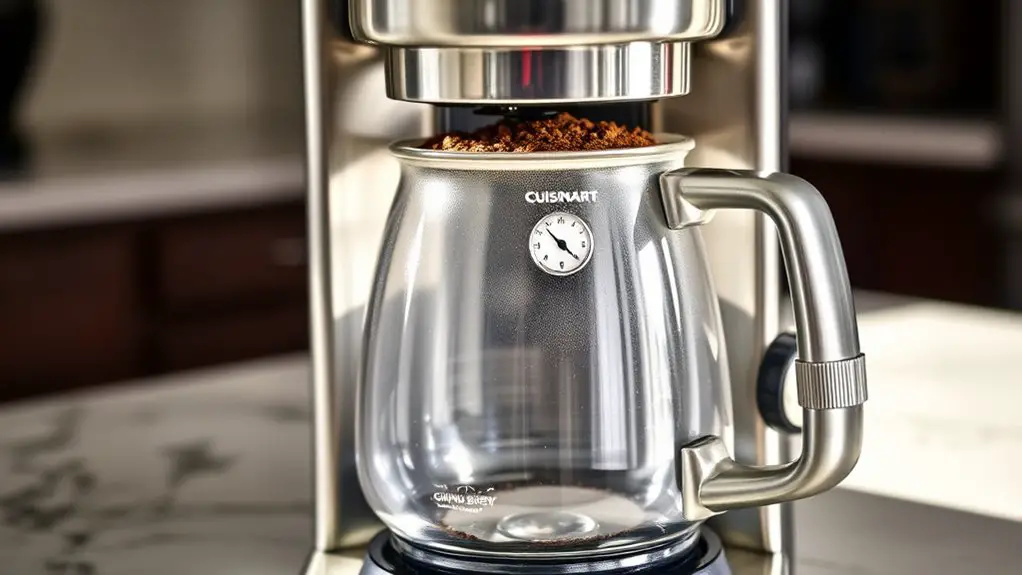If your Cuisinart Grind & Brew is producing weak coffee, it might be due to improper grind settings. Make sure your grind size is consistent; finer grinds increase surface area for better extraction, while coarser grinds result in milder flavor. Tweak your grind settings gradually, and also consider your coffee-to-water ratio—aim for about 1:15 for balance. Adjusting these factors can enhance your brew's strength considerably. There's more to mastering your coffee experience, so let's explore further.
Understanding the Causes of Weak Coffee
When brewing coffee, it's important to understand the factors that can lead to a weak final product. One major culprit is inadequate coffee extraction, which occurs when water fails to dissolve enough flavor compounds from the coffee grounds. This can happen if the brewing temperature is too low; ideal extraction typically requires water between 195°F and 205°F. If your brewing temperature falls below this range, you won't fully extract the rich flavors and aromas that make coffee enjoyable. Additionally, insufficient brew time can exacerbate this issue, as well. Ensuring that both your brewing temperature and extraction time are in the right range is vital for achieving a robust cup of coffee that satisfies your palate and spirit. Moreover, excessive coffee consumption can lead to increased gastric corrosiveness, affecting your overall coffee experience.
Importance of Grind Size
Although many factors influence the flavor of your coffee, grind size plays a critical role in determining extraction efficiency and overall taste. A consistent grind is essential for achieving ideal flavor extraction. If your grounds are uneven, some particles may over-extract while others under-extract, resulting in a muddled taste.
Fine grinds generally yield a stronger brew, while coarser grinds create a milder flavor. Adjusting the grind size impacts how water interacts with the coffee, affecting both the strength and complexity of the resulting cup. As a result, you must find the right balance for your preferred brewing method. Prioritizing grind consistency can enhance your coffee experience, allowing you to savor the rich flavors and aromas each brew has to offer. For espresso, it is recommended to use a fine grind to achieve optimal extraction and flavor.
Adjusting Your Grind Settings
Adjusting your grind settings is essential for tailoring your coffee to your taste preferences. Start by evaluating the grind consistency; a uniform grind helps extract flavors evenly during brewing. If your coffee tastes weak, try a finer grind, as this increases the surface area and enhances extraction. Conversely, a coarser grind may be necessary for a milder flavor, as it allows for a longer brewing time without over-extraction. Experiment with different settings to find the ideal balance between grind size and brewing time. Keep in mind that small adjustments can greatly impact your coffee's strength and flavor profile. By fine-tuning your grind settings, you can achieve that perfect cup that aligns with your personal taste. Remember that medium grind consistency is key to balancing flavor and machine compatibility.
Brewing Ratios and Their Impact
Understanding brewing ratios is essential for optimizing your coffee's flavor and strength. The ratio of coffee to water can greatly impact the final brew, affecting both extraction and overall satisfaction. For instance, using a 1:15 ratio (one part coffee to fifteen parts water) often yields a balanced cup. Experimenting with different brewing techniques can help you find your ideal strength.
Tips for Enhancing Coffee Flavor and Strength
To enhance the flavor and strength of your coffee, consider both the quality of your beans and the brewing process itself. Here are three essential tips to elevate your coffee experience:
- Coffee Bean Selection: Choose high-quality, freshly roasted beans. Look for single-origin or specialty beans that suit your taste preferences, as they offer unique flavor profiles.
- Grind Size: Adjust the grind size according to your brewing method. A finer grind increases extraction, while a coarser grind can produce a milder cup.
- Brewing Time: Experiment with brewing time to find your ideal balance. Typically, a longer brewing time extracts more flavor, but be cautious not to over-extract, which can lead to bitterness. Additionally, selecting beans with the appropriate roast level can further enhance your coffee's richness and overall flavor.
Implement these strategies to enjoy a richer, more robust coffee.
Frequently Asked Questions
How Often Should I Clean My Cuisinart Grind & Brew?
You should clean your Cuisinart Grind & Brew every few weeks, depending on usage. Regular cleaning guarantees peak performance. For maintenance tips, always remove coffee grounds and oils, preventing buildup that affects flavor and machine longevity.
Can I Use Pre-Ground Coffee in the Machine?
Wondering if you can use pre-ground coffee in your machine? Yes, you can! Just adjust the grind settings accordingly to guarantee ideal flavor. Experimenting might lead to your perfect cup—freedom's just a brew away!
What Coffee Beans Work Best With This Grinder?
When selecting coffee beans, consider types like Arabica for sweetness and brightness or Robusta for stronger, bitter notes. Experimenting with different flavor profiles helps you find the perfect balance for your brewing preferences.
Is the Machine Suitable for Making Espresso?
While your Cuisinart Grind & Brew excels at drip coffee, it isn't designed for espresso extraction. The pressure settings aren't adequate, limiting your ability to achieve that rich, concentrated flavor you crave in an espresso.
How Long Does the Brew Cycle Typically Take?
The brewing time for most coffee machines typically ranges from 5 to 10 minutes, with cycle duration varying based on the specific model and settings. Adjustments can influence both strength and flavor extraction during this process.
